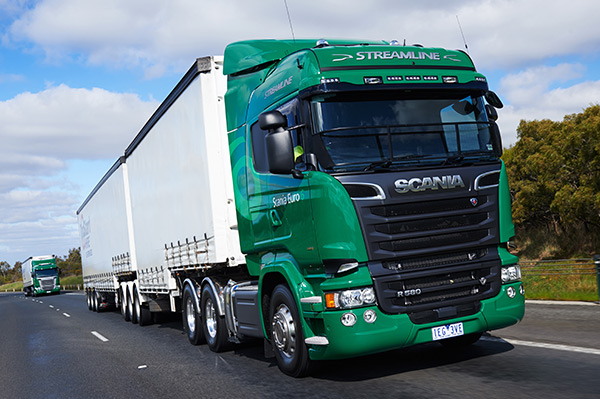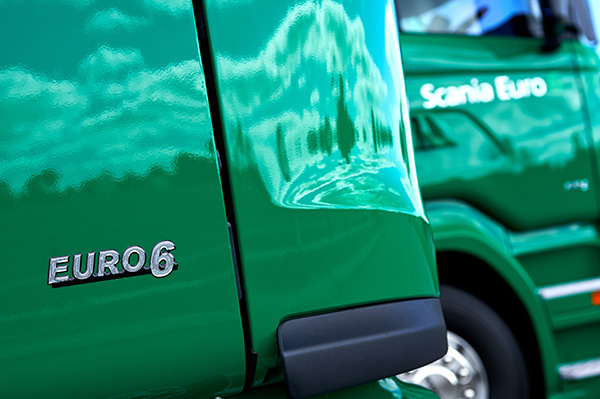Scania has been making a big push to own the Euro 6 market locally. It now offers Euro 6 compliant trucks across its range in Australia and two were available.
For a long time I was never a very relaxed flyer, though strangely enough it was large airliners that freaked me out more than being packed into a little Cessna.
To overcome this sense of unease I used to sit in my seat and scope out my fellow passengers and try and identify what role they would play in an aviation disaster.
Clearly the fat guy would die on impact but would the lady next to him emerge with a tough resilience?
Would the stressed out looking bloke in the business suit finally snap and have to be restrained in an emergency?
And who would I have to resort to eating if we were stranded in a remote location waiting for a rescue?
Volkswagen shenanigans
I’ve always imagined I was alone in this thinking, but at the moment I’d imagine that a variation of this reverie may well have been played out by some in the Volkswagen Group’s boardroom over the past few weeks.
The revelation that Volkswagen installed cheat software in cars equipped with diesel engines to dodge emissions regulations has scandalised the global automotive industry.
The fallout actually has resembled a slow motion plane crash. The big fella (CEO Martin Winterkorn) did indeed go on impact and I’m pretty sure the rest of the board are eyeing each other off and wondering who should be devoured before rescue arrives.
So with all that playing out in the media if I was at the helm of Scania I’d be pretty cranky right now.
Both Scania and MAN (also owned by Volkswagen) were well ahead of the game with the introduction of Euro 6 in Europe.
By the time Euro 6 lobbed, Scania already had more than 1,100 Euro 6 vehicles plying European roads.
The fact Volkswagen owns 90.47 per cent of Scania’s capital and 96.26 per cent of the voting rights (Source: New York Times) in a truck marque that has prided itself on being ahead of the game emissions wise must really smart.
Tight lipped
At the time of writing, Scania was still sown up tighter than a fish’s ear hole.
The only reference to the parent company’s woes came from Sweden based Scania press officer Hans-Åke Danielsson: “We cannot speculate and comment on ownership related issues, but we drive on with our business”.
He went on to emphasise that there is no technology-sharing between Scania and its majority stakeholder.
“Truck engines are so much more that we do not share any components. Nor are the same [emissions] test methods used.”
As painful as the scandal may prove to be for the world’s second largest auto maker, it may yet prove to be a double edged sword for Scania locally.
Discussion of diesel emissions has to date all but ground to a halt in Australia. A lack of political stability and a lack of political vision for transport in general have all but stalled the diesel emissions debate. However Scania has been carving its own little green niche in Australia.
An early jump into making Euro 6 available in its P, G and R series range has to date effectively given Scania ownership of the Euro 6 space.
Shock waves
As the shock waves from the Volkswagen debacle still echo through the global market, a normally lackadaisical public is starting to ask questions about Australia’s emissions standards and how they compare to other global markets. And these discussions are playing out in the mainstream media.
Commentators are asking why Australia is lagging behind the rest of the developed world in terms of emissions?
The fact that our city skylines are hardly clogged with smog probably contributes.
Human nature dictates that we only generally care about what is affecting us personally.
A large land mass and small population and Euro 5 smog laws mean at this stage our capital cities are hardly in danger of becoming smog choked.
Research by fuel companies such as Shell has found the overriding concern that most have about smog is ‘local’ air quality.
Not the air quality at a parking bay at Breadalbane.
Nor do many care about the quality of air over a Riverina rail siding, or for that manner the patch of sky over a heavy fuel-oil burning container ship hundreds of nautical miles off-shore.
Of course, in global terms this all ends up in the same atmosphere and has the same outcomes. You just can’t see it from your kitchen window.
Industry grumbles
The Aussie transport industry is still grumbling about Euro 5 and the initial reliability issues encountered by some engine makers that stemmed from its introduction.
And there are plenty who’ll point the finger at rail, shipping, construction and agriculture and point out the lack of an even playing field on diesel emissions and the high cost of compliance.
It’s worth noting while most agricultural and construction machines are still Tier 3 (roughly Euro 4), Aussie customers are starting to have to deal with selective catalytic reduction (SCR) and exhaust gas recirculation (EGR) (Tier 3b and Tier 4) in these sectors as well, mainly due to the fact that Australia is a low volume market that demands a high specification of product.
Which basically means in many cases we get what we are given if we want the latest in technology.
Burn less fuel
Really, the best way to reduce emissions is to burn less fuel, it’s really that simple.
But the same old issues around steer axle weights and truck dimensions keep rearing their ugly heads in the Australian emissions debate.
Aerodynamics can make a vehicle exceed legal dimensions and close coupling trailers and prime movers to reduce drag plays havoc with steer axle weights in a market that needs to carry a lot of juice on the truck.
A tolerance for a 2,550mm width and some common sense on steer axles could make a world of low-tech fuel saving solutions accessible to the average operator.
Every emissions step means a price increase for a new vehicle.
Yet there’s currently no financial incentive whatsoever for a trucking operator to make that step. Unless, of course, they’re using less fuel.
Especially when there’s also little incentive to use a new vehicle equipped with the latest in safety features and a clean exhaust pipe.
In short, if it makes sense for your business model to uses a 20-year-old oil burner, then you can go right ahead.
 |
|
Lean, mean and green. Scania now offers Euro 6 emissions level vehicles in P, G and R series trucks.
|
Reviewing the G490 and R580 Euro 6
Which brings me back to Scania.
I was recently able to take both the Scania G490 and R580 for an extended outing in Euro 6 guise recently to get a little more familiar with the Euro 6 V8 and 6 cylinder.
A loaded Melbourne-Sydney return seemed the ideal setting for a closer look at the Swedish green machines.
Setting off from Scania headquarters in the Melbourne suburb of Cambellfield.
We ambled up the Hume-boring Highway to Sydney town. I’d also been armed with the Scania Fleet Management app on my smartphone which meant that I could monitor the humiliation of being ranked as a driver during the journey and have my fuel efficiency and location monitored.
I jumped between the single trailer G Series and the B-double R Series during the trip up a stretch of road that by now I know every lump and bump of.
Engine and Transmission
The biggest news from behind the wheel of both trucks is there really is not that much news.
The big V8 still performs very much as it has in the past though the new aftertreatment system does dull the already faint bent eight exhaust note that little bit more.
A faint resonance through the floor and around 1,400rpm on a big pull is the only time that you’ll be really aware that 16 litres and eight pistons are putting out 2,175ft-lb (2,949Nm) of torque to drag you to the top.
The weight penalty for Euro 6 comes in at about 40kg and Scania is claiming no fuel penalty for the cleaner power plants.
As with most engine manufacturers the engines use both SCR and EGR to snatch all of the nasties out of the fuel burning process. There is however an SCR-only Euro 6 option available on the 450hp (336kW) 13-litre.
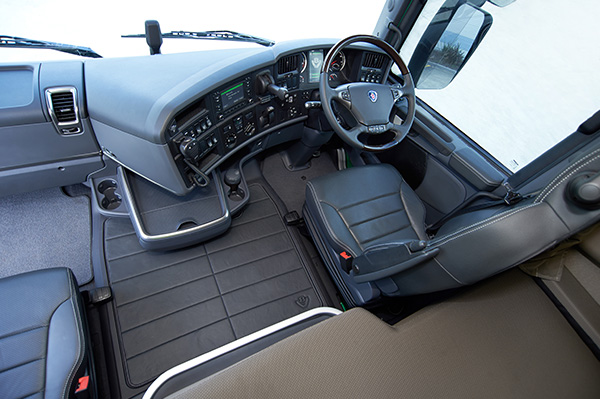 |
|
A corporate box at the G. The modular aspect of Scania’s range sees similar ergonomics regardless of model.
|
Cab and Controls
When given the time to ponder the R and G series cab, I realised nothing’s changed in that regard. Even the Euro 6 pong box hanging off the chassis hasn’t made much of an intrusion in terms of fuel capacity.
Sure the batteries now live down the back of the chassis to keep some weight off the front wheels but that is the same as the Euro 5 range.
Even taking into account the Streamline cab update, the P, G and R series trucks are all starting to look a little dated.
A steady stream of spy pics out of Europe seem to indicate that something may be on the go, however there’s nothing concrete to go on at this stage.
And my usual Euro criticism of a less than spacious bunk also applies here.
 |
|
The G Series cab makes it a pretty good all-rounder. Enough room for a snooze or the occasional night away.
|
Performance
The combination of EGR and SCR means both of the trucks I drove also featured a variable geometry turbocharger (VGT).
The performance of the V8 didn’t seem a great deal different than its Euro 5 stablemates, however the VGT did seem to give the little 13-litre six pot a shot in the arm performance wise.
This was really most noticeable when the engine was lugging down to 1,000-1,100rpm. It just seemed to hang on a little better than the last Euro 5 version I’d driven at 480hp (358kW).
Both trucks used Scania’s 12-speed Opticruise automated transmission and both were fitted with a hydraulic retarder.
Opticruise lets you switch between eco, normal and power modes to change shift patterns and throttle response. I played with this a bit during the drive.
South of the Murray River on the relatively flat plains of northern Victoria, eco mode did the job just fine. But either truck soon lost the will to live once some climbing was required. So I soon flicked back into normal mode.
The power option is really best for off-road use.
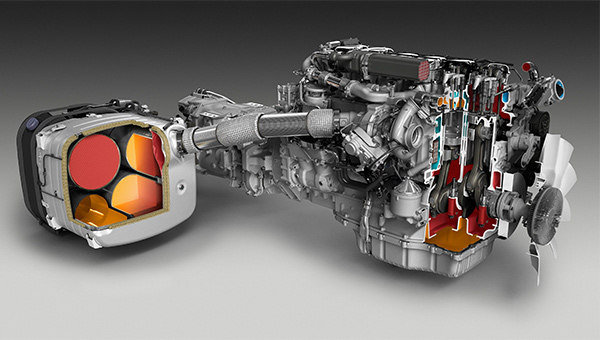 |
|
The Euro 6 13-litre engine and pong box. Interestingly, this set-up doesn’t take up much more chassis real estate compared to Euro 5 models.
|
Scania app
The Scania app kept giving me a real-time scorecard as a driver. Interestingly, I found I always scored better in the double than in the single trailer G Series.
I can only really put that down to the extra momentum of the heavier combination making it easier to coast over the crest of a hill.
The main aim of Euro 6 is to remove nitrogen oxides (NOx) from exhaust gases. In all other respects the difference between Euro 5 and 6 is minimal. But the hardware required to get a heavy duty diesel engine to that point is quite involved.
Scania now offers its entire V8 range in Euro 6 form, even the big 730hp (544kW) jobby.
Call me old fashioned, but I’m heartened to see the eight-banger survive where every other marque has dropped it.
Smooth power
There’s just something about the smooth way that a bent V engine puts power to the ground that is hard to replicate with an in-line six, even though a six generally has better weight distribution over the front axle.
In fact, engine capacity downsizing is the current global trend as engine makers strive to get more out of less.
The hairy chested bloke in me finds comfort in the fact a 16.4-litre V8 engine still not only exists but also meets the latest in emissions requirements out of Europe.
In fact, with the VGT, Scania is now claiming a wider torque spread across the V8 range. The 580hp (433kW) in Euro 6 guise gets the same performance figures as the current Euro 5 620hp (462kW).
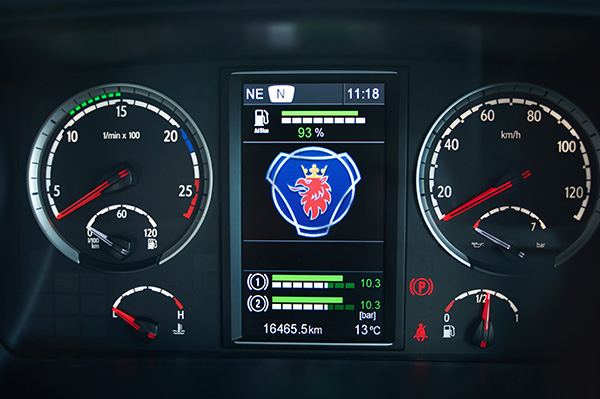 |
|
No surprises here, though I wish that percentage was my driving score not the fuel level.
|
Heading home
My return drive to Melbourne saw me parked in the G490 for the duration. It really is a sweet little truck to drive as a single.
The G cab does make a nice compromise between urban and highway work. Visibility is excellent which makes poking around town easy, yet it sits on the open road with ease.
This 13-litre six lugs like there’s no tomorrow and it took climbs such as Skyline, Wagga Hill and Aeroplane in its stride.
Verdict
My driving score according to the Scania app was a pretty awful 68 per cent. Which I wholeheartedly object to, it was clearly wrong.
But I did score 100 per cent for use of brakes which proves I mean it when I say I brake for nobody.
The six pot averaged 2.2km per litre for the return leg, which is not too bad for a truck that had less than 2,000km on the clock.
It’s hard to say at this point just how many operators will be tempted to jump into Euro 6 without it actually being mandated.
The most likely customers will be the big corporates who want to be seen as being innovators in the environmental space.
However, Scania is keen to be in the box seat if and when that mandate is set.
And the shenanigans of Volkswagen may just spur on that stalled debate.
In the meantime, my couple of days on the road indicated to me the added hardware and complexity of the Euro 6 driveline has served to improve rather than detract from the performance of the Scania line-up.
And it was so much better than flying …
Specifications
Make/model: Scania G490 6×4
Engine: 12.7-litre 6 cylinder (Euro 6 compliant using SCR and EGR)
Power: 490hp (365kW)
Torque: 1,880ft-lb (2,549Nm)
Transmission: 12-speed Opticruise automated
Final drive: 3.42:1
Make/model: Scania R580 6×4
Engine: 16.4-litre V8 (Euro 6 compliant using SCR and EGR)
Power: 580hp (433kW)
Torque: 2,175ft-lb (2,949Nm)
Transmission: 12-speed Opticruise automated
Final drive: 3.42:1













